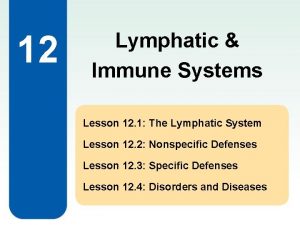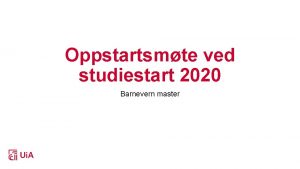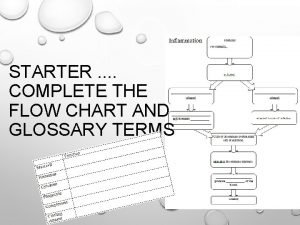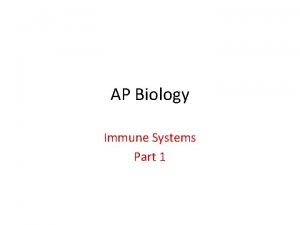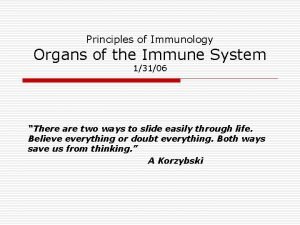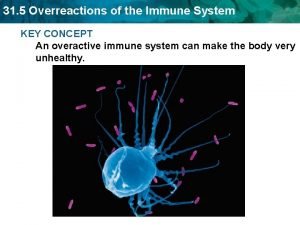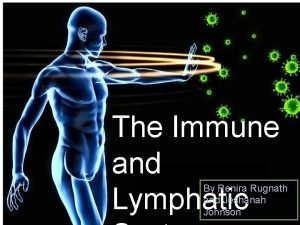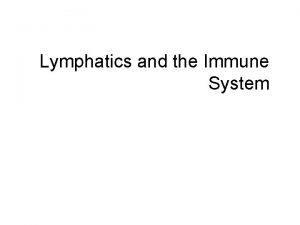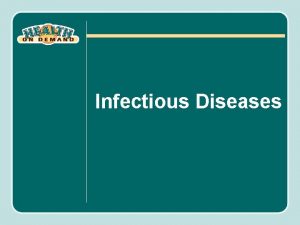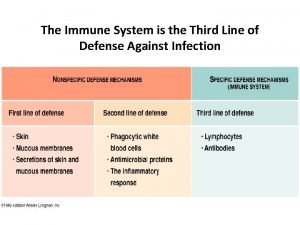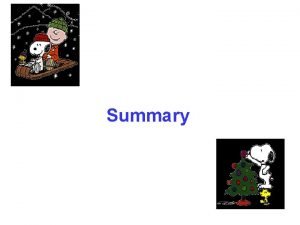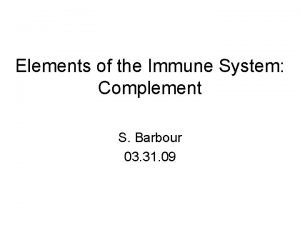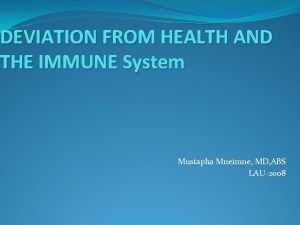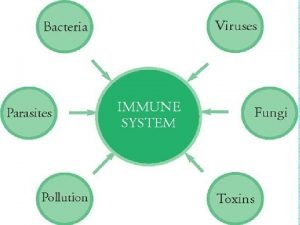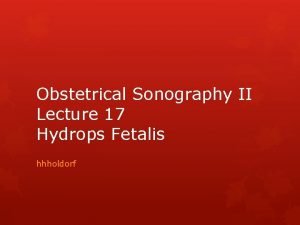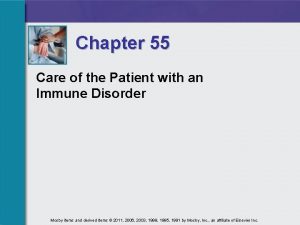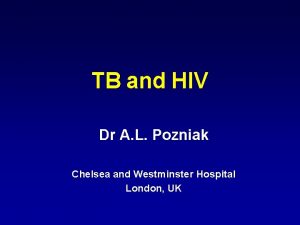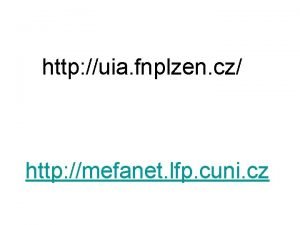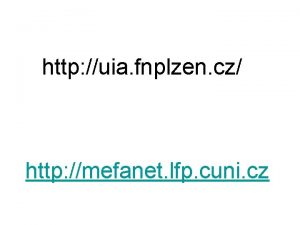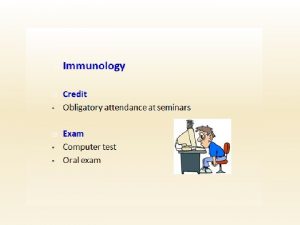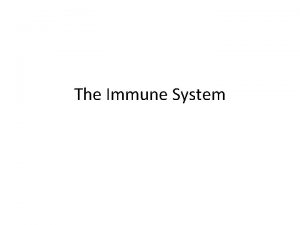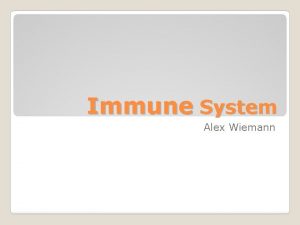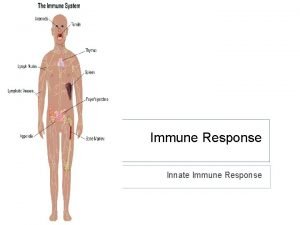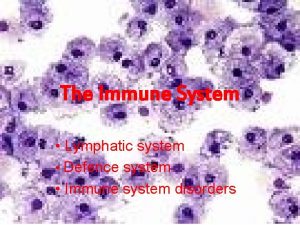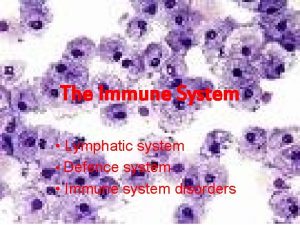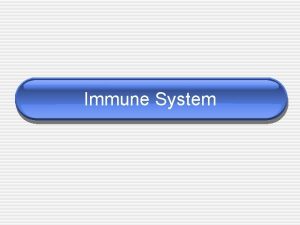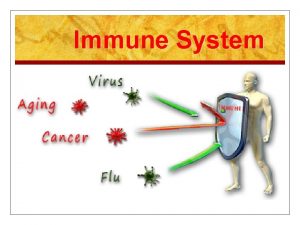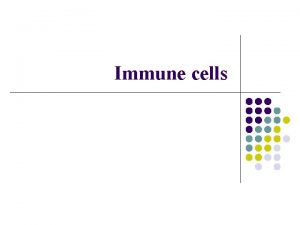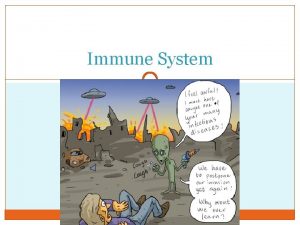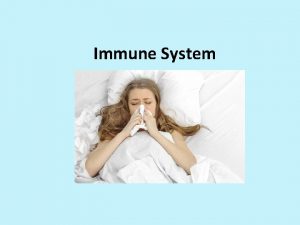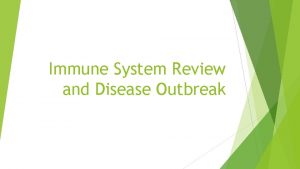http uia fnplzen cz 1 Immune system and


































- Slides: 34

http: //uia. fnplzen. cz/

1. Immune system and its importance for homeostasis. Components of the immune system and their cooperation. 2. Barrier functions of the human body and defense mechanisms. 3. Non-specific cellular and humoral immune mechanisms. 4. Specific cellular and humoral immune mechanisms. 5. Phagocytosis and its importance for immunity. 6. Neutrophils, their ontogenesis, and function. 7. Natural killer cells. Interferons. Characteristics and function.

The immune system and its importance for homeostasis The main functions of the immune system • Defense • Autotolerance • Immune surveillance

Components of the immune system • Lymphoid tissues and organs • Cells of the immune system • Molecules of the immune system

Primary lymphoid tissues and organs • Bone marrow, thymus • Maturation and differentiation of immunocompetent cells • Immature lymphocytes acquire here their antigenic specificity

Secondary lymphoid tissues and organs • Meeting place of immunocompetent cells with Ag • Spleen • Lymph nodes and their organized clusters (tonsils, appendix, Peyer patches) • • • MALT https: //www. youtube. com/watch? v=oqpq. Zplu. Oag https: //www. youtube. com/watch? v=c. CPy. WFK 0 IKs

Cells of the immune system • Locations of haematopoiesis: yolk sack (developing embryos), then travels to fetal liver and spleen (3 to 7 month of gestation), then bone marrow has the main hematopoietic function • All blood cells arise from a pluripotent hematipoetic stem cell (CD 34) • Haematopoiesis is regulated by cytokines


Barrier functions • Mechanical bariers: intact skin, mucosa, coughing, sneezing, vomiting, diarrhea, flushing of fluids • Chemical bariers: antimicrobial peptides (defensins), enzymes (lysozyme), acid p. H • Microbial barier: commensal microoranisms • Other factors: body temperature 37 o. C, tissue oxygen tension https: //www. youtube. com/watch? v=3 tssjxk 5 Wxg

Non-specific cellular and humoral immune mechanisms • Non-adaptive, innate • Evolutionarily older • No immunological memory • In the presence of pathogens react quickly, in minutes (based on molecules and cells which are in the body prepared in advance) • Cellular components – granulocytes (neutrophils, eosinophils, basophils, mast cells), monocytes (macrophages, DC), NK cells • Humoral components - complement, interferons, lectins and other serum proteins

Specific cellular and humoral immune mechanisms • Adaptive, antigen-specific • Evolutionarily younger • Have immunological memory • Development of a full-specific immune response takes several days even weeks • Cellular component - T lymphocytes (TCR) • Humoral component - antibodies

Cooperation between nonspecific and specific immune mechanisms • APC – T cell • TH 1 – macrophage • Ig. G, Ig. M – complement activation • Ig. G, Ig. A – opsonization • …

Phagocytosis and its importance for immunity

Phagocytosis = ability to absorb particles from the surroundings https: //www. youtube. com/watch? v=i. ZYLe. IJwe 4 w

Professional phagocytes • Protect the body by ingesting harmful foreign particles, bacteria, and dead cells • Neutrophils • Monocytes, macrophages • DC

Neutrophils • The most prevalent leukocytes (cca 70%) • Active in defense against extracellular microbes • Granulocytes • Staining with H&E – pink gray • Segmented nucleus (2 -5 seg. ) • Granules in cytoplasm: primary (azurophilic) granules – myeloperoxidase, defensins, lysozyme… secondary (specific) granules – lysozyme, lactoferrin, proteolytic enzymes

Macrophages • Remove dying or dead cells and cellular debris • Defense against some intracellular pathogens • APC • Alveolar macrophages, Kupffer cells, osteoclasts, microglia… • Intracellular destruction of microorganisms mainly by means of NO syntethase (the system is stimulated by IFN-g and TNF)

The migration of phagocytes into damaged and infected tissues 7% of peripheral neutrophils and phagocytes 93% neutrophils and phagocytes in the bone marrow Phagocytes are captured on endothelium in the place of damage (due to inflammatory cytokine expression of adhesion molecules is higher)

Phagocytosis • selectins, integrins • rolling • diapedesis (or extravasation) • chemotaxis (IL-8, MIP-1 a and b, MCP-1, RANTES, C 3 a, C 5 a, bacterial products. . . ) • https: //www. youtube. com/watch? v=i. VCXRa 8 Fd. P 0

PRR (pattern recognition receptors) • Recognize PAMPs (pathogen associated molecular patterns) and DAMPs (damage associated molecular patterns) • TLR (Toll-like receptors) • CLR (C-type lectin receptors) • mannose receptor • galactose receptor • CD 14 (for bacterial LPS) • scavenger receptors • ….

Opsonisation • Enhances phagocytosis of an antigen • Antigen is marked with opsonin • Opsonins - Ig. G, Ig. A, C 3 b, MBL, fibronectin, fibrinogen, CRP, SAP • Fc receptors, complement receptors (for C 3 b) • https: //www. youtube. com/watch? v=o. IZwbfv. MY 5 Q

Phagocytosis

Degradation of ingested material • Fagosome fusion with lysosomes - oxygen independent (lysozyme, defensines, serine proteases, myeloperoxidase, acidic p. H…) • Activation of membrane NADPH oxidase - oxygen dependent (superoxide, hydrogen peroxide, hypochlorous acid) • Production of nitric oxide (NO) by macophages

Neutrophils have three ways of attacking pathogen: phagocytosis, degranulation and the formation of NETs

Phagocyte products • Proinflammatory cytokines (IL-1, IL- 6, TNF, L-8) • Cytokines promoting production of phagocytes (IL-3, GM-CSF) • Cytokines promoting tissue healing (TGFa, TGFb) • Arachidonic acid metabolites (prostaglandins, prostacyclins, leukotriens and tromboxanes)

NK CELLS INTERFERONS

NK cells § Lymphoid cells which belon to innate immunity § Kill cells which have abnormally low HLA I expression (some tumor and virus infected cells) § Have similar cytotoxic mechanisms as Tc § NK cells activators - IFNa, IFNb

NK cells receptors § Activating receptors § § § Some surface lectins Fc receptor CD 16 Inhibitory receptors - recognize MHC gp. I § Imunoglobulin family - KIR (killer cell immunoglobulin like receptors) § C-type lektin family - eg CD 94/NKG 2


ADCC (antibody-dependent cellular cytotoxicity) • NK cells express CD 16 which recognize Fc part of Ig. G antibodies attached to the surface of a cell, this leads to the activation of NK cell cytotoxic mechanisms

NK cell cytotoxic mechanisms • Cytotoxic granules (perforins and granzymes) • Fas ligand • TNFa • https: //www. youtube. com/watch? v=HNP 1 EAYLh. Os

Interferons • IFNa - produced by virus infected lymphocytes, monocytes and macrophages • IFNb - produced by virus-infected fibroblasts and epithelial cells • IFNa and IFNb - bind to receptors on the surface of infected and healthy cells and induce in them an antiviral state (synthesis of enzymes that block viral replication in the cell); NK activation, ↑ HLA I expression • IFNg - produced by TH 1 cells, regulatory function, activates macrophages (NO synthase, NADPH oxidase), ↑HLA expression

Interferons https: //www. youtube. com/watch? v=tb. K 93 J 6 fsa 8

Thank you for your attention
 Primary immune response and secondary immune response
Primary immune response and secondary immune response Chapter 35 immune system and disease
Chapter 35 immune system and disease 1st 2nd and 3rd line of defense immune system
1st 2nd and 3rd line of defense immune system Lesson 12 blood and immune system
Lesson 12 blood and immune system Lesson 12 blood and immune system
Lesson 12 blood and immune system Lingual tonsil
Lingual tonsil Uia lisieux
Uia lisieux Uia barnevern
Uia barnevern Uia form 1027
Uia form 1027 Opptakskontoret uia
Opptakskontoret uia What is the third line of defense in the immune system
What is the third line of defense in the immune system Hangman flowchart
Hangman flowchart Third line of defense immune system
Third line of defense immune system 1st line of defense immune system
1st line of defense immune system Ap bio immune system
Ap bio immune system Immune system lymph nodes
Immune system lymph nodes Immunity definition
Immunity definition Overreactions of the immune system
Overreactions of the immune system Lymphatic vs immune system
Lymphatic vs immune system Lymph return
Lymph return Defination of immune system
Defination of immune system What is the first line of defense
What is the first line of defense What is the main function of the immune system
What is the main function of the immune system Thymus immune system
Thymus immune system Immune complex
Immune complex Thalassemia facies
Thalassemia facies 1what's the purpose of the body's immune system?
1what's the purpose of the body's immune system? Chapter 24 the immune and lymphatic systems and cancer
Chapter 24 the immune and lymphatic systems and cancer Chapter 24 the immune and lymphatic systems and cancer
Chapter 24 the immune and lymphatic systems and cancer Primary and secondary immune response
Primary and secondary immune response Hydrops fetalis
Hydrops fetalis Active artificial immunity
Active artificial immunity Chapter 55 care of the patient with an immune disorder
Chapter 55 care of the patient with an immune disorder Immune checkpoint inhibitors mechanism of action
Immune checkpoint inhibitors mechanism of action Immune reconstitution inflammatory syndrome
Immune reconstitution inflammatory syndrome




